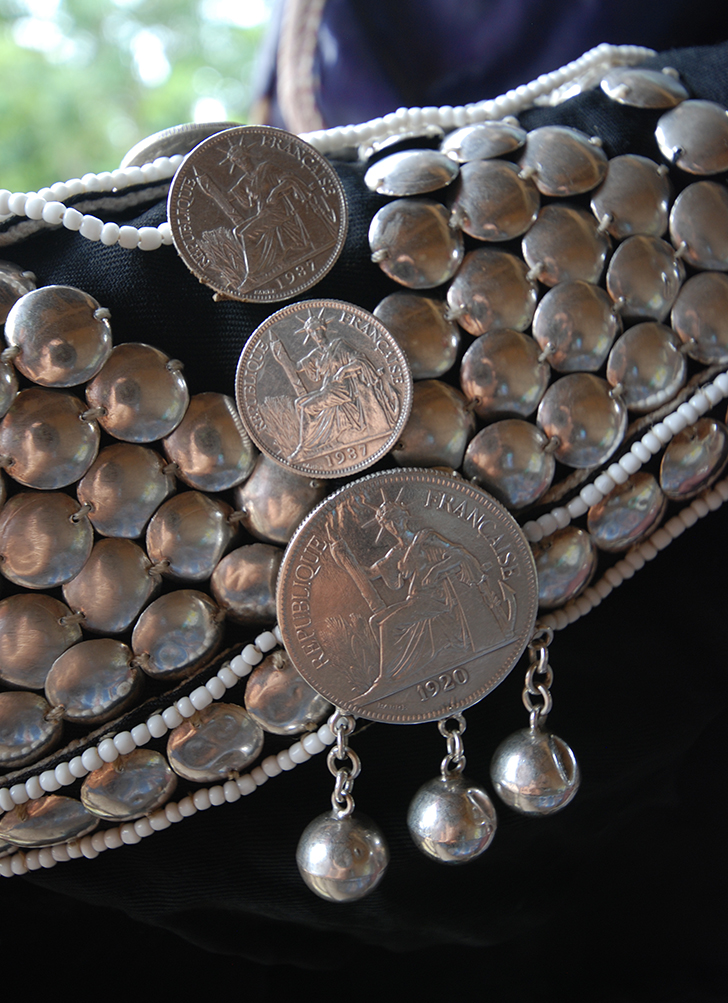Their magnificent headdress makes the Akha one of the most recognizable, iconic ethnic groups in Southeast Asia. We take a closer look at their traditional garb.
On a recent trip to Muang Sing in far northwest Laos, I visited an Akha village for the first time. Though I had been living in Laos and Southeast Asia for several years, I felt like I was in another world, so different were the mannerisms, attitudes and dress from any I had ever encountered or experienced in the region. The visual impression was striking yet familiar, as if I had seen it in a book or gallery. I am one in a long line of explorers, writers, anthropologists to be curious about the Akha. The tribe’s elaborate headdress has made them one of the most recognizable, iconic ethnic groups in Southeast Asia.
The Akha village visits in Muang Sing and the headdress made a lasting impression on me. At what point did I become fascinated? Was it when I observed an old woman put her head wear on, endlessly building elaborate piece on elaborate piece? Was it when I was allowed to pick one up and was startled at how heavy it was? Or perhaps it was when I arrived to one village mid-wedding and in all the excitement and activity, heads overwhelmed with polished silver quivered and glimmered around me.


The Akha Headdress
The Akha are one of the more diverse ethnic groups in Southeast Asia, and at least 18 of the 28 sub-divisions are found in Laos. Each sub-division can be identified through geography, genealogy and clothing down to the minute details such as colour and embroidery (which the women are highly skilled at). But overall, the woman’s magnificent headdress holds the most distinction, the shape and style varying significantly between groups.
“In the traditional Akha view art is something one wears…To an Akha, art is the adornment of everyday being and to wear it is to make a statement at once ethnic, personal and aesthetic,”
Jim Goodman, Meet the Akhas (1996).
In Laos, the Akha women have managed to resist Lao clothing. Early descriptions from Mekong explorers tell us that not much has changed from their costume since the 19th C. A striking aspect about the headdress is that traditionally it’s worn year round and everyday, while working and even while sleeping (they protect it by wrapping their head with a cotton cloth). It may be difficult for the modern world to comprehend this practice – I personally shun cumbersome clothing – but understand, the headdress is very much a part of their identity.
It begins as a baby: the mother makes a cap of embroidered cloth for her infant – the girl’s adorned with feather tassels, a boy’s with pom-poms. As the girl grows older, more coloured threads and tassels are added. At around 12 years old, a girl’s cap is changed to that of a young girl’s and she begins to collect silver. At maturity, she is allowed to wear an adult headdress, elaborate and fully decorated with beads, silver buttons and balls. An Akha Puly Nyai woman’s headdress on display at the Traditional Arts & Ethnology Centre in Luang Prabang is comprised of 10 separate pieces and has over 300 silver ornaments.

Materials
Seeds like small, white “Job’s Tears” are used. So are coloured beads, the glass beads of yore now replaced by plastic. Some groups use feathers and pom-poms. Cowrie shells are still used; they were traditionally traded to a variety of tribes in the region and became a sign of wealth, having come to this landlocked nation from afar.
Above all silver is prized, especially coins, a clear statement of wealth and status. Old colonial silver coins like French-Indochina piastre or silver rupees from British India are valued. Poorer people use baht coins. Silver is pounded and fashioned into coins and balls. Valuable ornaments become heirlooms passed on from generation to generation.

How to put on an Akha Headdress – a visual guide
An Akha Puli woman in Muang Sing, Luang Namtha Province, Laos. It took her 10 minutes to complete the process. Observe each step, accessory and layer.
 The Akha Puli group (sometimes spelled Pouly) are concentrated in the Sing District of Luang Namtha Province, but are also found in Bokeo and Oudomxai Provinces. In 1995, there were 45,000 of them, or 68% of the 66,000 Akha in Laos. (Source: Joachim, Schliesinger. 2003. Ethnic Groups of Laos, Volume #4, Sino-Tibetan Speaking Peoples)
The Akha Puli group (sometimes spelled Pouly) are concentrated in the Sing District of Luang Namtha Province, but are also found in Bokeo and Oudomxai Provinces. In 1995, there were 45,000 of them, or 68% of the 66,000 Akha in Laos. (Source: Joachim, Schliesinger. 2003. Ethnic Groups of Laos, Volume #4, Sino-Tibetan Speaking Peoples)
The Akha in Laos, Just the Facts
Ethnolinguistic group: Sino-Tibetan/Tibeto-Burman
Number of Subgroups: 28
Number of Subgroups in Laos: at least 18
Population in Laos, according to 2005 National Census: 90,698
Population in Laos, according to 1995 Census: 66,108
Where in Laos: Bokeo, Oudomxai, Luang Namtha, Phongsaly
Where in the world: 2-3 million people in China, Laos, Thailand, Myanmar, Vietnam
Resources:
Goodman, Jim. (1996). Meet the Akhas. Bangkok: White Lotus Co Ltd.
Schliesinger, Joachim. (2003). Ethnic Groups of Laos, Volume #4, Sino-Tibetan Speaking Peoples. Bangkok: White Lotus Co Ltd.
Matesai www.matesai.com
Tradtional Arts & Ethnology Centre (TAEC), Luang Prabang www.taeclaos.org

